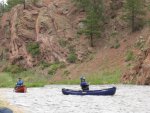johnnyrover said:
Long time listener...first time caller
Wenonah and Bell make awesome boats, and are both built within 20 minutes of my house, but I would recommend you look at the Old Towne Penobscot (in royalex) as your first canoe.
For the money...
It has good initial and secondary stability, handles loads well, and tracks well when solo...They are also very durable in Royalex, and well suited as an all around canoe.
From here, you can begin to learn what form and function best suit your paddling needs.
If you are going to look at an Old Town then I agree the Penobscott series is the best. However keep in mind that in comparison to a Bell or Wenonah the Royalex laminate from Old Town is not as good. The laminate is thinner which wil make the boat slightly lighter however these canoes can suffer from "oil canning" as they age. Defenitly a great starter canoe. Keep in mind thought that Royalex in comparison to Kevlar is heavy and that Old Town spec wieghts are very very optomistic. I will tell you that the weight of reality vs catalog spec on O.T. canoe is as high as 15% more then catalog spec weight. THere have always been a big variable witht his brand and I am not sure why.
Just make sure you get to try one out on the water before you purchase because they all sound good in the catalog. Although a good canoe shop can lead you the right size of boat they cannot tell you which one is going to be the most stable. Stability has alot of influences. Like you natural sense of balance, comfort with water, athletic ability etc. Everyone has different comfort level and canoe do feel different on the water even with very close specs.
For me what I value in stability is something the industry does not really speak of. The industry speaks of initial stability which is the canoes basic resistance to leaning. They also talk talk about the secondary stability which is how far the boat can lean before a capsize. I look at what I call transitional stability. This is the measure of how the canoe moves from sitting level to leaning on its side. Most flat bottom canoes with straight sides have great initial stability however when they get to a certain point they roll to the side wildly and this most often causes the flip. People over react to the sudden transition. Canoes with rounded or v bottoms and heavily flared sides tend to have great secondary but they can be a chore to relax in because the boat is constantly leaning left and right so you feel as if you are going to possibly fall over even though that design gets more stable the further it leans. Unfortunetly most manufacturers over due the secondary and it is beyond most peoples comfort zone. So the the object is to be somewhere in the middle. Something with mild flare and a mid arch to the center hull section is usually where you will find a boat with good transitional stability. It will feel stable enough on flat water as well as choppy conditions. A boat with great transitional stability will move from level to fully leaned at a rate that feels comfortable. The canoe will not make you think uh oh hear we go. You will say to yourself up le are leaning left and then you will compensate for that without violently going for the "high side". It should feel natural. This is wy demoing a cnaoe first is important.
I also highly recommend spending a few dollars on a class. Paddling is much like skiing. You can strap on a set of skis and go for it which usually leads to a less then successful experience, or you take a lesson and get ahead of the curve and enjoy it from the start. Mastering a few basic strokes are paramount to a good experience. You should learn how to handle the canoe while it is still this includes moving the canoe sideways and spinning it in circles. You should learn how to do a proper forward stroke and stop. Then you are ready to learn how to make the canoe go straight and finally turn while under way using bow control. There are about 8 strokes that will make your paddling experience go from a canoe trip to a great canoe trip.

